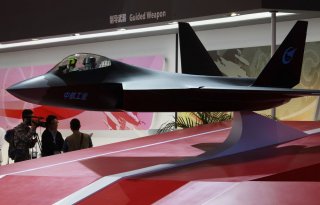How China Stole and Copied Its Way Into Creating a Highly-Networked Military
Surprise surprise, a Chinese newspaper is reporting that the People’s Liberation Army is now linking its Army and Air Force units into a single, unified combat alert duty in an effort to connect air defense radar and communications with PLA ground brigades.
Here’s What You Need to Remember: China’s visible effort to steal specs, copy U.S. platform designs and in many instances closely replicate U.S. weapons systems is both well documented and widely known. However, a less visible yet equally significant aspect of this phenomenon may well be found in apparent Chinese efforts to mirror U.S. military tactics and modernization strategies.
The United States has for many years now been developing and emphasizing multi-domain operations with a mind to how new technologies are creating synergies, opening up data sharing networks and inspiring fast-moving and sweeping tactical adjustments to modern warfare preparations. U.S. Army, Navy and Air Force multi-domain task forces have been operating in the Pacific for several years now, exploring new realms of joint combat interoperability, tactics and strategies.
During Project Convergence in the Fall of last year, U.S. Army ground forces succeeded in exchanging key targeting specifics with overhead F-35Bs in what was a breakthrough air-to-ground and ground-to-air multi-service connectivity demonstration.
Now, surprise surprise a Chinese newspaper is reporting that the PLA is now linking its Army and Air Force units into a single, unified combat alert duty in an effort to connect air defense radar and communications with PLA ground brigades.
“Thanks to the integration, the Army air defense brigades have become key nodes in Air Force early warning systems, as Army radars are more accurate and make up for blind zones of the Air Force’s early warning network, the report said, noting that the Army also gained a longer detection range that enabled troops to find enemies and prepare for attacks earlier, as the Air Force shares all intelligence through the network,” the Chinese-backed Global Times reports.
Sharing intelligence through a network, as described by the Chinese paper, is something that seems to be an obvious combat strategy, has taken on new meaning and tactical relevance in the age of AI, cyber hardened connectivity, long-range sensors and precision weaponry. Weapons platforms are no longer merely attack systems but also “nodes” on an interconnected information sharing warfare network, forming a “kill web.”
This Chinese move to network air and ground air defenses, may or may not be particularly advanced, as its effectiveness will pertain to the quality of the network transport layers, hardened or “jam-proof” signal transmission, data analysis and organization, near real-time analytics and information processing. All of these things are maturing quickly within the U.S. military which has just within the last year or two hit several new levels of joint interoperability and massively expedited sensor-to-shooter time cycles. The Army’s Integrated Battle Command System, for instance, builds a web relay between otherwise dispersed or disconnected radar nodes, enabling target track sharing which has in several instances shown it can interoperate with air platforms such as an F-35.
It would not seem to be a stretch at all to view these PLA joint-maneuvers as a visible effort to replicate the Pentagon’s emerging Joint All Domain Command and Control program. The relative success of any kind of attempted Chinese multi-domain interoperability, and the way it reshapes combat tactics and maneuver formations, will rely in large measure upon the strength, speed and security of its networks. That is what will be necessary to bring the new tactical landscape to fruition as nodes or combat positions will increasingly be more dispersed, disaggregated and separated by distances and different domains.
Kris Osborn is the defense editor for the National Interest. Osborn previously served at the Pentagon as a Highly Qualified Expert with the Office of the Assistant Secretary of the Army—Acquisition, Logistics & Technology. Osborn has also worked as an anchor and on-air military specialist at national TV networks. He has appeared as a guest military expert on Fox News, MSNBC, The Military Channel, and The History Channel. He also has a Masters Degree in Comparative Literature from Columbia University.
Image: Reuters
This article was first published earlier this year.

